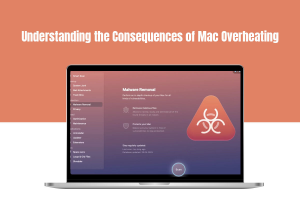
Is your Mac too hot to touch? Yes? Well, this is not good news. If your powerful and sleek Mac computer starts to break a sweat, it means there’s something wrong. It would be best if you investigated right away.
Mac computers are designed to run like a breeze. To ensure they can do their job, you must see that your system is as cool as a cucumber. Otherwise, you are destined for a lot of pain.
Are you wondering what kind of pain we are referring to? Let’s explore the consequences of an overheated Mac. But before that, you must know how to check your system’s temperature so you can quickly make changes to cool it down.
Checking Mac’s Temperature
Mac is your trusted ally and your best friend when it comes to completing professional or personal tasks. It is your 2 a.m. Netflix binge partner and 8-hour-long work partner.
Hence, keeping a close eye on your Mac’s internal temperature would be best to prevent overheating. Here is how to check CPU temp on Mac:
- Open the Activity Monitor and review the system parameters, such as CPU and memory usage. Although the Activity Monitor does not directly display the temperature, a sudden spike in CPU usage indicates an increased heat generation. If you notice this, quitting the processes and programming contributing to the sudden spike in CPU usage is recommended.
- iStat Menus, Macs Fan Control, and other third-party applications are available at your disposal to get accurate and detailed information about your Mac’s internal temperature. These apps offer information for GPU, CPU, and other Mac components.
- Are you tech-savvy? If so, you can use Terminal to check the temperature of your system. Launch Terminal and enter “istats or temperature.”
What are the Consequences of an Overheated Mac?
- Subpar performance
Performance is one of the primary aspects affected when a Mac overheats. The system cannot function at its full potential because the internal temperature is unbearable. The system automatically slows down to prevent irreversible damage to its internal components.
So, you cannot use resource-hungry applications or multitask when your computer is too hot. This may impact your workflow and cause delays in project completion.
- Deterioration of battery’s lifespan
Mac’s battery wears and tears with time. However, this process is accelerated if the internal temperatures are too high. Therefore, the battery’s lifespan might be reduced, and you may have to replace the battery sooner rather than later.
- Loss of data
SSDs or HDDs get damaged due to extreme heat, which results in data loss.
- Irreversible hardware damage
Overheating results in irreversible damage to the internal components of a Mac computer, such as the motherboard, GPU, and CPU. Repairs can break your bank.
- Loud and noisy fans
The fans begin to work harder in order to combat overheating. This makes them extremely noisy and may disrupt your work environment.
Please note that if you ever hear loud fan noises, it is a clear sign that your Mac is struggling, and you need to take steps to bring down the internal temperature.
Additionally, overheating results in system instability. Hence, you will be encountering frequent problems, such as unresponsiveness, unexpected shutdowns, etc.
Do you know why Macs Overheat? Let’s see
Overheating is not a Mac-specific problem. All computers are prone to overheating, and if you are running multiple resource-intensive programs, this is normal. Overheating is only a cause of panic when the phenomenon starts occurring frequently and without any rhyme or reason.
If you are not running intensive tasks like 3D games or video editing software and yet your computer is getting overheated, it is because:
- Dirt, dust, and debris have accumulated inside your Mac and clogged the cooling system. This is preventing the dissipation of heat and heating up your computer.
- You have placed your computer on a soft surface or in a place where there is limited airflow. Hence, heat is getting trapped due to poor ventilation.
- You are using an outdated macOS version. Due to this, the system resources are not being managed efficiently, and your computer is working twice as hard.
So, How can you Prevent your Mac from Overheating?
- Place your computer on a flat, hard surface to ensure there is proper ventilation. Also, a well-ventilated workspace will help.
- Do not let dirt or dust accumulate and clog the vents of your Mac. Implement a regular cleaning routine.
- Close all the resource-intensive applications and programs if they are not required.
- Always keep the macOS version up-to-date.
The Bottom Line
So, now you know the consequences of an overheating Mac and the steps to take to maintain an efficient and cool computer.
If your Mac is as chill as a polar bear, you can enjoy a trouble-free computing experience. Also, your device will last longer, and you don’t have to incur extra expenses in repairing the internal components of your computer.

